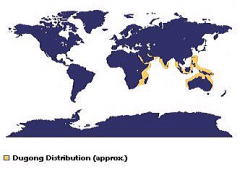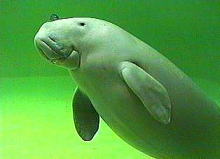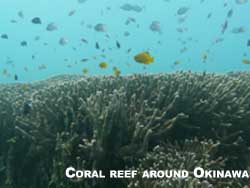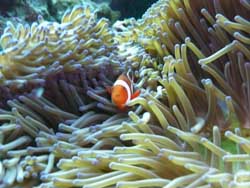
The dugong is similar to the manatees and is also called the Sea Cows.
The dugong is found in coastal and island waters between East Africa and East side of Australia. The dugongís range spans at least 37 countries. Though the total population size is unknown, it is said there are approximately 100,000 dugongs in the world. The majority of the dugongs live in the northern waters of Australia . Owing to hunting, habitat degradation, and fishing-related fatalities, dugong populations are declining.
The World Conservation Union (IUCN) listed the dugong as a species vulnerable to extinction in 2001. Once the dugong population is critically reduced, it is remarkably hard to increase the population size again. Thus, we need to stop the population reduction right now.
The reasons why the population increase is difficult are in dugong's ecology and life history.
The dugong is a big sea mammal which weights about 300kg (660lb) and is about 3 meter (10ft) in length. The female dugong does not become sexually mature until at the age of 8-10. Also, the gestation in the dugong is 14 month, much longer than that of humans. They usually have a single young. The female dugong takes care of the youth for about 18 month while they do not bear another youth. With the long gestation period and the extensive parental care, one female dugong only has 5 to 6 children in their life (Dugong life span is 50 to 70 years).
Moreover, the dugong is very vulnerable to environmental destructions because of their limited diet. They are herbivore animals which heavily depend on seagrasse (need a photo here) for their subsistence. They have no alternative in their diet. They need to eat about 10 % of their weight every day which means they need to look for approximately 30kg of seagrass each day. A decent area of seagrass beds need to be protected for each dugong.
The protection of costal and island waters is important to save the dugong as the waters are the only areas where seagrass can grow.
The Okinawa Dugong used to live anywhere around Okinawa. However, they only survive along the northeast coast of the main Okinawa Island. Its population is about 50 or less. The Japanese Ministry of the Environment classified the Okinawa dugong as "critically endangered" on its Red List in August, 2007. The dugong is also listed as a "Natural Monument" under Japanís "Cultural Properties Protection Law".
The west coast of the main Okinawa Island is no longer suitable for the dugong to live. The environment has been destroyed by human activities such as wetland fills, road constructions in the forests (a major cause of soil erosion), and water pollution from sewage discharge. The waters of the east coast of main Okinawa Island are integral parts of one of the most pristine and unique ecosystems in the world which sustain a high degree of bio-diversity. These areas, especially around the Oura Bay and Henoko, are the last place for the Okinawa Dugong to survive.
The new construction plan of the military airport at Henoko was proposed in 1996. Many people are concerned that the construction of the military airport destroys the last dugong habitat in Okinawa. It is planned to be constructed over seagrass beds.
UNEP report
The United Nations Environment Programme (UNEP) released a report on the dugong in February 2002, which urges Japan to protect the dugongs. The report advocates the Japanese government to designate dugong habitats as marine protected areas and to implement an environmental impact assessment that reflects international standards. It also warned that the dugongs will be driven to extinction in near future unless measures to protect the dugongs are taken immediately.
Court Decision on the Okinawa Dugong in California, the U.S.
"A U.S. federal judge ordered the Defense Department to consider the impact of a proposed base in Okinawa on the dugong, an endangered marine mammal."
From Japan Times, Jan 26, 2008. (Another article from the Earthjustice here)
This remarkable decision encouraged groups like us and many anti-base people. The U.S. had been avoiding its responsibility on the new airport construction. With this decision made, they can no longer say "itís not our responsibility because it a project that Japan, a sovereign nation, organizes as "
Ninety days were given to the Defense Department to submit documents describing its plan to assess the project's effects on the dugong and to develop ways to reduce its impacts. Their documents were submitted in April. We think the docume
nts were not sufficient to conserve the environment for the dugong.
In the IUCN congress in October 2008, we are expecting to have deeper discussions about the responsibility of the U.S. government than we had last time. It has been clarified that the Department of Defense has a responsibility on the construction plan and the Okinawa Dugong conservation .





Encouraging news on the Okinawa Dugong from the world!